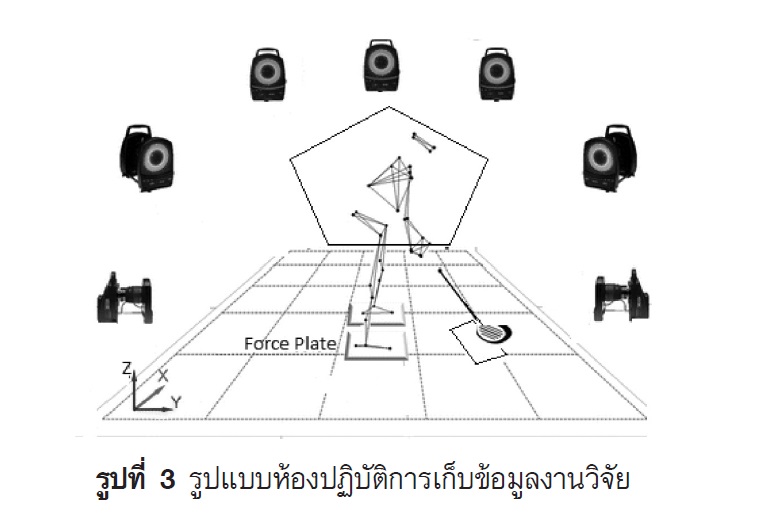ความสัมพันธ์ระหว่างระยะทางเชิงมุมและความเร็วเชิงมุมของการหมุนสะโพกกับความเร็วหัวไม้และระยะทางในการตีกอล์ฟของนักกีฬากอล์ฟระดับมหาวิทยาลัย
Main Article Content
บทคัดย่อ
วัตถุประสงค์ : เพื่อศึกษาความสัมพันธ์ระหว่างระยะทางเชิงมุมและความเร็วเชิงมุมของการหมุนสะโพกกับความเร็วหัวไม้และระยะทางในการตีกอล์ฟ
วิธีดำเนินการวิจัย : นักกีฬากอล์ฟสมัครเล่นระดับมหาวิทยาลัย เพศชาย จำนวน 19 คน กลุ่มตัวอย่าง ได้รับการทดสอบโดยการตีกอล์ฟ จำนวน 3 ครั้งด้วยแรงที่มากที่สุด (Maximum efforts) และมีเวลาพักระหว่างการตีครั้งละ 1 นาที โดยผู้วิจัยติดมาร์กเกอร์จำนวน 35 จุด เพื่อนำข้อมูลมาวิเคราะห์โดยเลือกจากลูกกอล์ฟที่ตีได้ไกลที่สุดมาวิเคราะห์โดยใช้โปรแกรม Vicon and bodybuilder program เพื่อวิเคราะห์การเคลื่อนไหว 3 มิติ คำนวณระยะทางเชิงมุมและความเร็วเชิงมุม การหมุนสะโพกด้วยวิธีการทางเวคเตอร์ และใช้โปรแกรม P3 Pro Swing Golf Simulator เพื่อบันทึกและวิเคราะห์ข้อมูลของระยะทางในการตีกอล์ฟ และความเร็วหัวไม้
ผลการวิจัย : พบว่า ความสัมพันธ์ระหว่างระยะทางเชิงมุมและความเร็วเชิงมุมของการหมุนสะโพกอยู่ในระดับสูง (r=0.95, p<0.01), ความสัมพันธ์ระหว่างความเร็วหัวไม้และระยะทางในการตีกอล์ฟอยู่ในระดับสูง (r=0.99, p<0.01), ความสัมพันธ์ระหว่างระยะทางเชิงมุมการหมุนสะโพกกับความเร็วหัวไม้ อยู่ในระดับปานกลาง (r=0.54, p<0.05) และความสัมพันธ์ระหว่างระยะทางเชิงมุมของการหมุนสะโพกและระยะทางในการตีกอล์ฟอยู่ในระดับปานกลาง (r=0.51, p<0.05)
สรุปผลการวิจัย : ระยะทางเชิงมุมและความเร็วเชิงมุมการหมุนสะโพกสัมพันธ์กับความเร็วหัวไม้และระยะทางในการตีกอล์ฟ ดังนั้นการเพิ่มระยะทางเชิงมุมและความเร็วเชิงมุมของสะโพก จะทำให้ความเร็วหัวไม้และระยะทางเชิงมุมเพิ่มขึ้น
Article Details
References
Beak, S. H., Choi, A., Choi, S. W., Oh, S. E., Mun, J. H., Yang, H., Song, H. R. (2013). Upper torso and pelvis linear velocity during the downswing of elite golfers.BioMedical Engineering OnLine, 12(1), 13.
Cole, M. H., & Grimshaw, P. N. (2016). The Biomechanics of the Modern Golf Swing: Implications for Lower Back Injuries. Sports Medicine, 46(3), 339-351.
Gordon, B. S., Moir, G. L., Davis, S. E., Witmer, C. A., & Cummings, D. M. (2009). An investigation into the relationship of flexibility, power, and strength to club head speed in male golfers. The Journal of Strength and Conditioning Research, 23(5), 1606-1610.
Horan, S. A., Evans, K., Morris, N. R., & Kavanagh, J. J. (2010). Thorax and pelvis kinematics during the downswing of male and female skilled golfers. Journal of Biomechanics, 43(8), 1456-1462.
Kwon, Han, K. H., Como, C., Lee, S., & Singhal, K. (2013). Validity of the X-factor computation methods and relationship between the X-factor parameters and clubhead velocity in skilled golfers. Sports Biomechanics, 12(3), 231-246.
Mun, F., Suh, S. W., Park, H. J., & Choi, A. (2015). Kinematic relationship between rotation of lumbar spine and hip joints during golf swing in professional golfers. BioMedical Engineering Online, 14, 41.
Rakthof, F. (2015). Nieuw bij Fysio Rakthof: Golf-Fysiotherapie. Retrieved from https:// fysio rakthof.nl/2015/03/31/nieuw-bij-fysiorakthof- golf-fysiotherapie/
Sim, T., Choi, A., Lee, S., & Mun, J. H. (2016). How to quantify the transition phase during golf swing performance: Torsional load affects low back complaints during the transition phase. Journal of Sports Science, 1-9.
Sinclair, J., Currigan, G., Fewtrell, D., & Taylor, P. (2014). Biomechanical correlates of club-head velocity during the golf swing. International Journal of Performance Analysis in Sport. (Vol. 14), 54-63.
Sommer, M., & Rönnqvist, L. (2009). Improved Motor-Timing: Effects of Synchronized Metro-Nome Training on Golf Shot Accuracy. Journal of Sports Science & Medicine, 8(4), 648-656.
Walker, B. (2007). The Stretching Handbook: Walkerbout Health; 3rd edition
Zheng, N., Barrentine, S. W., Fleisig, G. S., & Andrews, J. R. (2008). Kinematic analysis of swing in pro and amateur golfers.International Journal of Sports Medicine, 29(6), 487-493.

